Programmatic SEO simplifies the process of creating hundreds of website pages, each targeting a unique keyword. This SEO strategy marries technology and automation to bypass the manual creation of pages. Through solid keyword research, a well-built template, database sourcing, and automation, this strategy can help your various web pages rank on search engines.
This enables targeting a larger pool of related keywords in a business’s niche. In this method, while the targeted keyword may change, the overall layout of the various landing pages remains the same. The process is automated rather than having your team create near-identical pages for each target keyword, freeing up time for other SEO endeavors.
Websites like eBay have succeeded through programmatic search engine optimization (pSEO) strategies. However, there are plenty of ways businesses can leverage a programmatic SEO methodology. But how does it work? Let’s dive into this approach that has been a key component of success for some of the world’s most recognizable websites.
Programmatic SEO vs. Regular SEO: What’s the Difference?
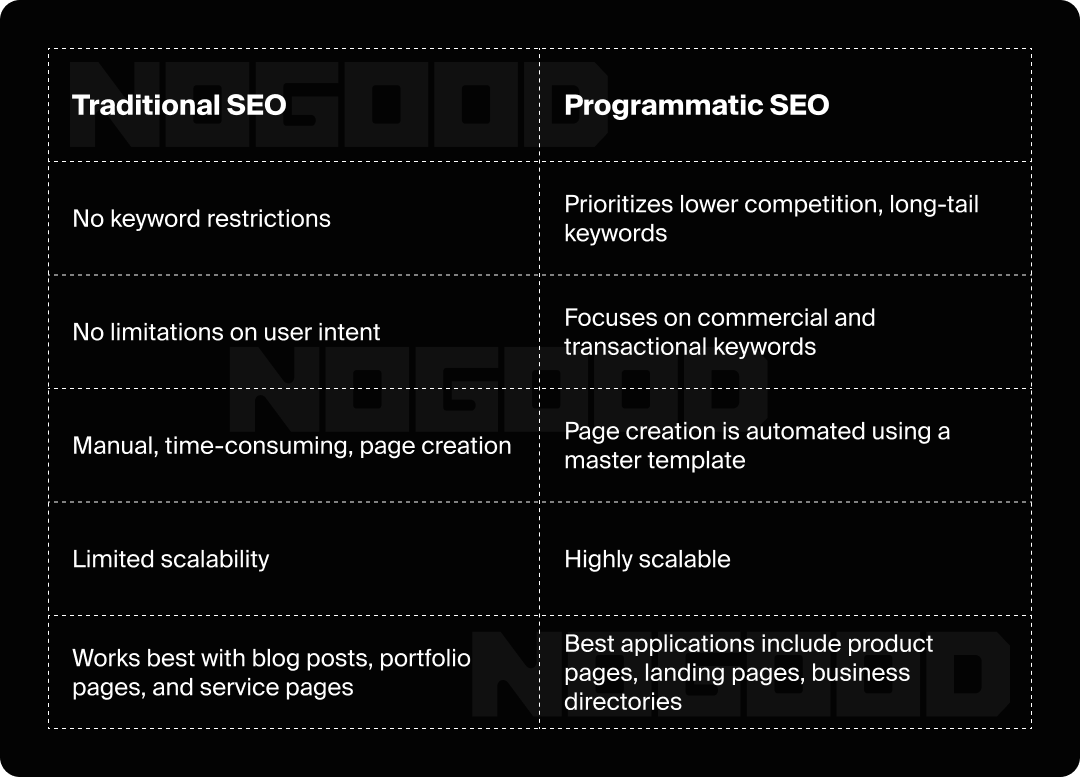
Here’s the scoop: Traditional SEO involves manually creating pages for each targeted keyword, whereas programmatic SEO leverages automation to speed up this process and ensure consistency and quality. This makes it easy and efficient to target hundreds of keywords in no time.
Programmatic SEO can also work with complex content structures in ways that may be too time-consuming to build and update with traditional, manual SEO. This includes pages with product variations, faceted navigations, content hubs, and personalized recommendations.
Additionally, while user experience remains a priority in both approaches, the focus differs. Programmatic SEO aims to deliver relevant information quickly through tools such as comparisons, reviews, and structured data, which can enhance transactional intent fulfillment.
On the other hand, traditional SEO often prioritizes depth and storytelling, emphasizing the quality of the content, which may take longer to develop. Ultimately, both strategies have their merits, but programmatic SEO stands out as an innovative solution for businesses wanting to maximize their online presence in a competitive digital landscape.
Industry Applications of Programmatic SEO (With Examples!)
eCommerce and Amazon
Leveraging programmatic SEO in eCommerce is a lucrative strategy for optimizing product pages, category pages, and search results in real time, improving search engine rankings and user engagement.
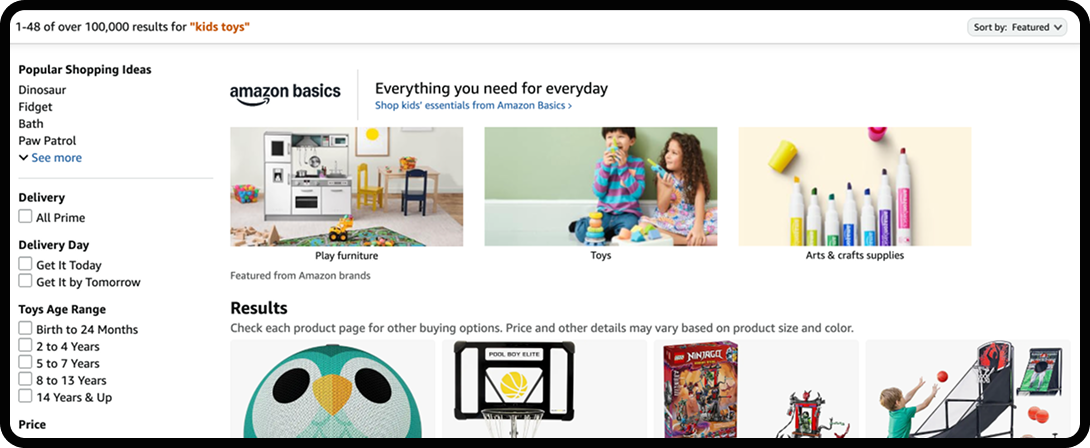
Take the world’s number one eCommerce platform: Amazon. With 3.6 billion monthly users, they’re clearly doing something right. With its enormous product catalog, Amazon relies on a programmatic strategy to create thousands of pages so users can find anything from baby products and home furniture to electronics, art supplies, and more. Through automation, Amazon manages and optimizes each of these pages while ensuring they’re correctly indexed.
Rather than tackling generic keywords, Amazon’s system optimizes each product page with schema markup so search engines (including its own on-page search function) can quickly and accurately understand product information and suggest it in relevant user queries. Amazon also leverages machine learning in its programmatic SEO strategy to collect information on user behavior, search patterns, and product performance to improve its algorithm.
Travel Booking Platforms and Tripadvisor
Programmatic SEO enables automated optimization of listings on travel booking platforms with relevant keywords and meta tags. Additionally, booking pages can automatically offer personalized recommendations. These features can increase conversion rates by providing relevant search results to users.
Take Tripadvisor as an example.

Tripadvisor is a fantastic resource for planning a trip. From their website, you can attend to almost all your travel needs, from researching and booking hotels, flights, cruises, and even finding things to do. With about 130 million monthly visitors, Tripadvisor’s website is a classic example of a successful programmatic SEO strategy.
Tripadvisor’s success story relies on leveraging programmatic SEO to automate and scale content creation for millions of long-tail keywords. And while these pages maintain a neat and consistent format, they are anything but basic.
Each page provides location-specific information so users can find all the information they need directly on the website. A single page offers a map view, reviews, booking links, weather information, the best times of year to visit, related stories, and an FAQ section.
A best-case scenario for a programmatic SEO strategy is the ability to offer personalized information through aggregated outside resources while keeping its content engaging, interesting, and fresh.
Financial Services and NerdWallet
By optimizing financial product pages, enhancing customer support pages, and including relevant filters and search engine features, businesses in the financial services sector can improve their conversion rates through relevant and personalized search results.
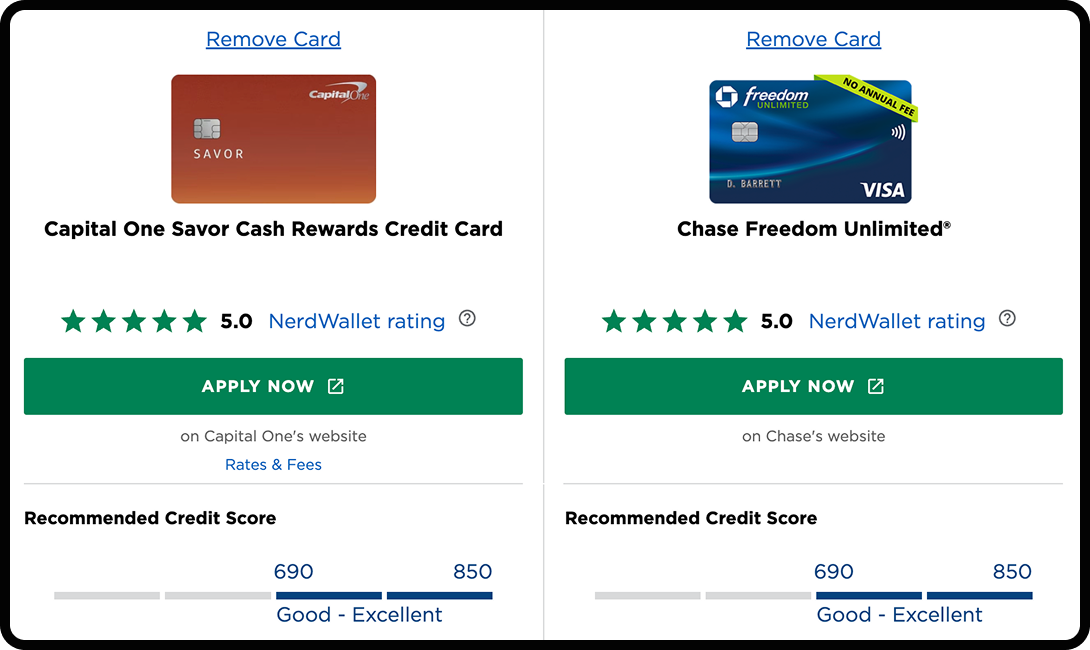
NerdWallet’s website provides another example of programmatic SEO at work, but this time in the financial services sector. NerdWallet provides financial literacy resources, comparisons of financial products, and tailored advice. By employing programmatic SEO, NerdWallet has successfully scaled its content and improved its visibility in search engine results.
NerdWallet uses automated systems to generate numerous landing pages targeting specific financial queries. For instance, when it comes to credit cards, the platform can create dedicated pages for various card types, benefits, usage tips, and comparisons tailored to different demographics, such as students or frequent travelers. This high level of automation allows them to cover a broad spectrum of topics quickly and efficiently.
A critical aspect of NerdWallet’s programmatic SEO strategy is the emphasis on user experience. They create content that answers specific user queries while ensuring the information is clear, accurate, and actionable. By offering calculators, comparisons, and tailored advice, NerdWallet not only drives traffic but also provides significant value to its users, enhancing the chances of conversions.
Real Estate and Zillow
Real estate companies, property management firms, and agents can use programmatic SEO to instantly optimize property listings, search results, and neighborhood guides. This improves user engagement and SERP rankings.

Zillow acts as an online marketplace where website visitors can buy, sell, rent, and even finance their homes. One key way they leverage programmatic in their SEO strategy is by automatically generating property pages for each listing that’s added. These pages are populated with detailed descriptions, images, and metadata, all crucial for SEO while remaining informative and helpful to website users.
Like Tripadvisor, you can browse for information on different neighborhoods, cities, and zip codes. These pages aggregate data on market trends, school ratings, and local amenities, making them highly relevant for users searching for specific information about real estate in those areas. This strategy enhances Zillow’s visibility for a wide range of location-based searches.
By employing these programmatic SEO strategies, Zillow has successfully established itself as a leading resource in the real estate market, generating millions of page views and ranking for a vast number of keywords. This approach not only improves their search engine visibility but also enhances the overall user experience on their platform.
Advantages of Programmatic SEO
Scaling and Efficiency
Programmatic SEO automates the creation and optimization of web pages, significantly reducing the time and effort required compared to traditional SEO methods. This allows businesses to handle extensive catalogs and a larger pool of keywords efficiently.
Keyword Targeting
Programmatic SEO targets a much vaster pool of keywords and leverages automation tools to generate large amounts of pages to target that pool of terms. Programmatic strategies use algorithms and tools to identify long-tail keywords, user search patterns, and trends across large datasets.
On the other hand, traditional SEO is a much more manual process, completing keyword research analysis and optimization the old-fashioned way. With SEO, content is optimized for both a primary target keyword as well as a group of secondary key terms. Keyword optimization in traditional SEO is generally more tactical, involving on-page adjustments like title tags, meta descriptions, and content updates to target specific search terms.
Consistent Content Creation
When it comes to content on your website, keeping some level of consistency across the board is crucial. Programmatic SEO utilizes dynamic templates designed to incorporate specific keywords, data points, and content structures, allowing the mass creation of content with consistent formatting.
Additionally, programmatic SEO relies on data-driven insights to guide content creation. By analyzing user intent, trends, and keyword opportunities, it automates the creation of pages targeting specific search terms, particularly long-tail keywords. This process allows for rapid automated content generation and a constant flow of fresh content.
Increased Visibility
By producing a large volume of pages targeting various keywords, businesses enhance their visibility in search engine results, increasing the likelihood of attracting diverse segments of their target audience.
Cost-Effective
Although initial setup may require investment in the right tools and technology, the long-term cost savings from reduced manual labor and improved efficiency can make programmatic SEO a cost-effective solution.
Disadvantages of Programmatic SEO
Quality Concerns
Without proper oversight, automated content generation can produce lower-quality pages due to its lack of a human touch. Automation lacks the creative elements humans can produce. This can lead to pages that lack depth, relevance, or engagement.
Lower-quality content can hurt a website’s reputation and lead to higher bounce rates. This is why it’s crucial to have your team carefully review any content generated from this process.
Potential for Duplicate Content
If you’re not properly tracking your website’s content gaps and existing content, programmatic SEO can result in similar or duplicate content across multiple pages. Duplicate content can negatively impact search rankings and frustrate your website visitors.
Technical Complexity
Implementing programmatic SEO requires a level of technical knowledge and expertise in automation tools and coding. For some businesses, this can be a significant barrier to entry.
Search Engine Algorithm Changes
Search engines frequently update their algorithms, and automated strategies that once worked may become ineffective over time. Keeping up with these changes and adjusting strategies accordingly can be challenging, especially when employing programmatic tools and methodologies.
Programmatic SEO Key Considerations
Plan Your Internal Linking Strategy
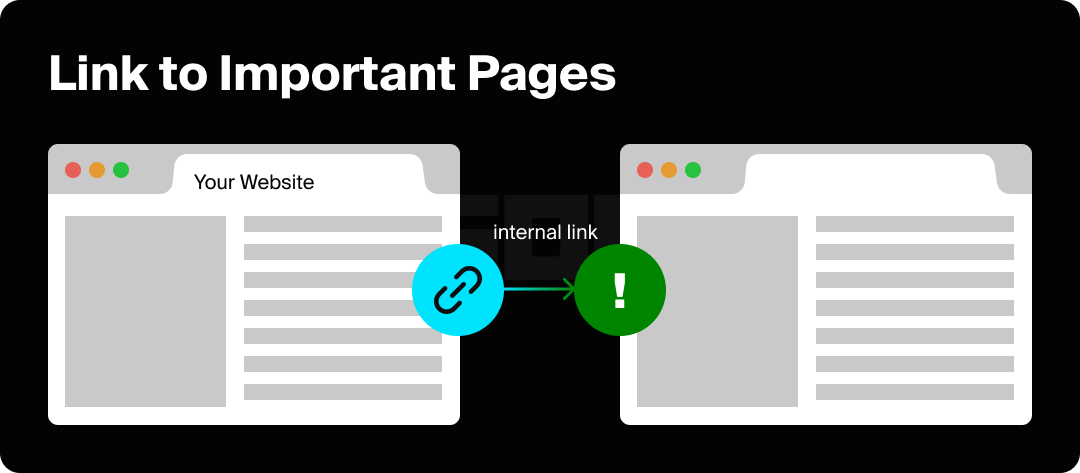
Internal linking, which refers to links in your content that lead to other pages on your website, is key to any SEO strategy. Internal links help search engines understand what your page is about and how your other pages connect and fit together.
When search engines understand the hierarchy of your website structure, they can better crawl and index your website. This is crucial when dealing with thousands of programmatic pages, as it helps prioritize which pages should be crawled and indexed, ultimately improving visibility in search results.
Additionally, high-authority pages can pass on link equity (link juice) to lower-authority pages through internal links. This is particularly valuable in a pSEO context, where acquiring backlinks for every landing page is likely impractical. By linking your well-trafficked and authoritative pages to your newly created landing pages, you can boost rankings more effectively.
Here are some things to consider when planning your internal linking strategy:
- Frequency: Link to your most important pages frequently to help users navigate your website.
- Link density: The proportion of links present in your content compared to text content. A good rule of thumb is 1-2% of links to text.
- Anchor text: Be selective about where you put your internal links. The anchor text should describe the nature of the linked page. So instead of making your anchor text vague like “click here,” you’re better off using relevant text. If I was linking this post to another blog of ours, I might use something like “programmatic SEO” as my anchor text.
- Link consistency: To maintain a professional appearance, consider how you’ll keep your internal linking strategy consistent across the website.
Remember that your strategy should be relevant to the user’s original intent and help guide them to additional helpful information.
Build Your Editorial Foundation
Having a solid editorial foundation to support your programmatic SEO efforts is crucial. A well-built foundation ensures you maintain an organized, structured user experience. The proper fundamentals and a solid base support your programmatic SEO strategy by aligning your new content with the quality content you’ve already created, ensuring each piece continues to provide value to users.
With a programmatic strategy, you want to build off of your existing trust and credibility. Traditional SEO relies heavily on establishing domain authority and trust through high-quality editorial content. A strong editorial foundation lays the groundwork for creating authoritative content, which can enhance the effectiveness of programmatic SEO efforts by improving the site’s overall credibility in the eyes of search engines.
Indexing is Key
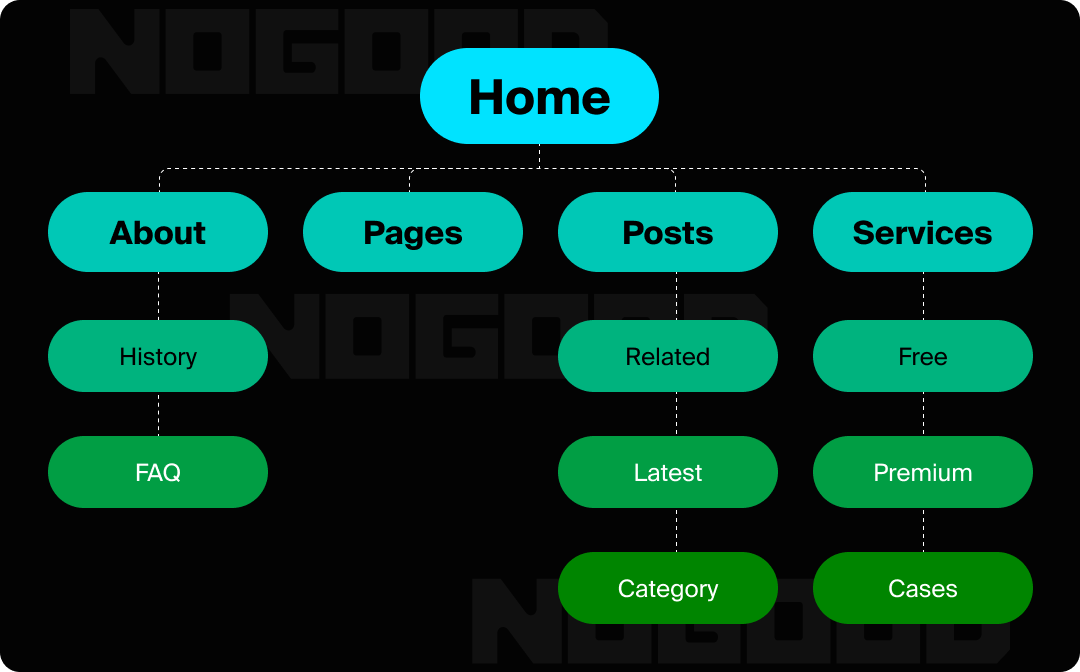
Another absolute must for programmatic SEO is ensuring your website is indexed. Indexing ensures that each web page generated through programmatic gets included in search engine databases. Without proper indexing, even the best-optimized pages will not appear in search results, limiting your website visibility and the potential to attract organic traffic.
Programmatic SEO also leverages structured data to optimize pages for search engines. Proper indexing of these pages is essential for search engines to correctly interpret the structured data and display rich snippets, which can enhance click-through rates (CTR) and ultimately drive more traffic to your website.
Below are some tips for ensuring search engines index your website:
- Create a Sitemap: Building a sitemap helps illustrate your website’s structure, content, and navigational hierarchy.
- Submit Your Sitemap: Search engines like Google, Bing, and Yahoo all have their respective webmaster tools where you need to submit the sitemap of your website.
- Use Header Tags: Header tags (H1, H2, H3, etc.) provide structure and organization to your content, making it easier for search engines to crawl and understand.
- Focus on User Experience (UX): Metrics like page load times, website speed, and mobile-friendliness all impact UX. Good UX improves your website indexability.
Differentiate Your Content
There’s a lot of competition on the internet. No matter your industry, hundreds of others will likely compete for the same website visitors you want. Because of this, it’s imperative to differentiate your content from that of your competitors and the content already existing on your website.
Search engines like Google prioritize unique content. If your programmatic SEO strategy results in numerous pages with identical or nearly identical content, you risk running into duplicate content issues. This can lead to penalties or reduced visibility in search engine results, as search engines may struggle to determine which page to rank.
Aside from search engines, actual users also want unique and informative content. Users are more likely to engage with content tailored to their needs and interests. By differentiating your content, you can provide a more personalized and relevant experience, therefore increasing user satisfaction, reducing bounce rates, and ultimately leading to higher conversion rates.
Build Backlinks
Like traditional SEO, link-building is also a crucial aspect of programmatic SEO. Programmatic SEO focuses on automating the creation of numerous landing pages to increase visibility and drive organic traffic. While the rapid generation of content is a significant aspect, integrating robust link-building strategies amplifies the effectiveness of your efforts.
There are many strategies for building backlinks; however, the ones you employ depend on the nature of your business and overall programmatic SEO strategy. Here are the best strategies for link-building to your programmatic pages:
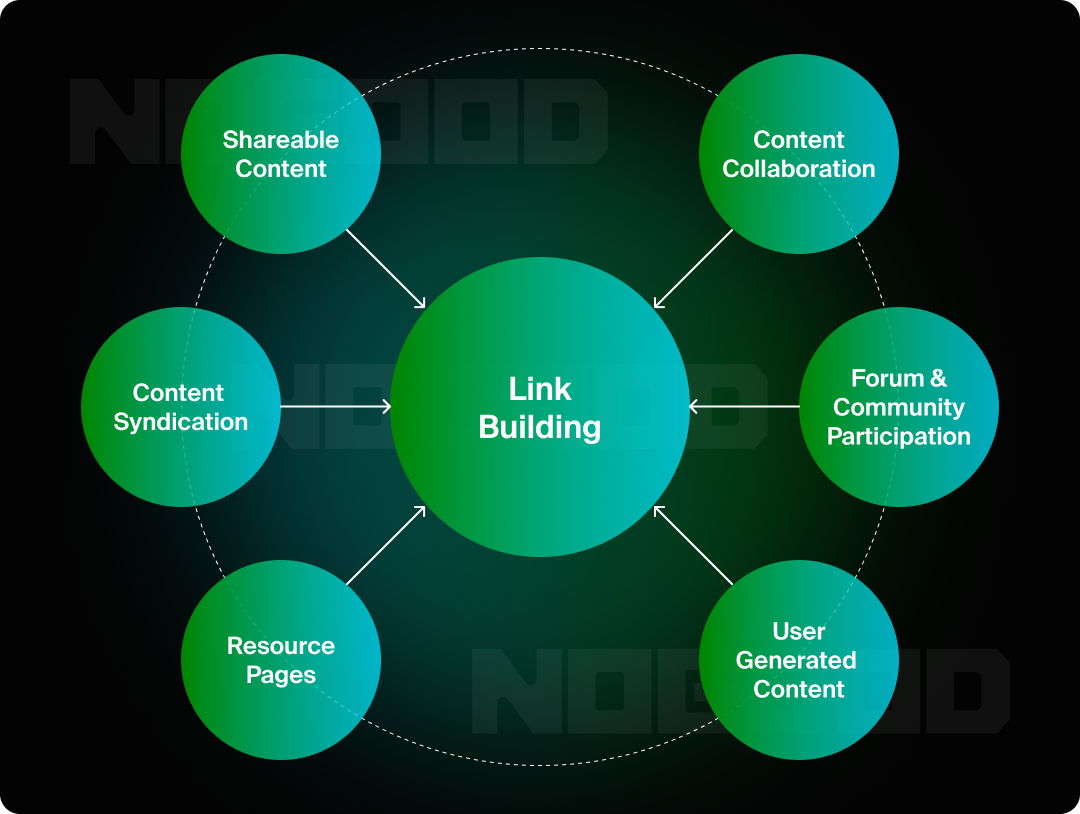
- Shareable Content: Developing valuable tools, calculators, or downloadable guides and infographics can act as a magnet for backlinks. These resources are often shared widely, attracting links from users who find them beneficial.
- Content Syndication: Consider syndicating your content on platforms like Medium or LinkedIn Pulse. This helps expand your reach while allowing you to include links back to your original landing pages, which can enhance your backlink profile.
- Resource Pages: Some websites maintain pages full of resource links or link directories for their website visitors to access. If your pages could be a helpful addition, reach out to these websites to see if they’d be willing to include your link.
- Content Collaboration: Collaborate and build partnerships with other websites to create podcasts, videos, or other relevant content. Both parties mutually benefit by enhancing the authority of your content while generating backlinks from established, relevant sources to your target pages.
- Forum and Community Participation: Join industry-specific forums, Q&A sites like Quora, and other online communities. Contribute valuable insights and link to your pages when relevant. This not only allows you to organically earn backlinks, but simultaneously establishes your business as an authority in your field.
- User-Generated Content: Encourage users to share their experiences. When users engage with your product or service and share their stories on their platforms, they often link to your pages. This enhances engagement while organically increasing backlinks from personal blogs and social shares.
Programmatic SEO: SEO Scaled Up
Overall, programmatic SEO presents a compelling solution for businesses wanting to enhance online visibility rapidly and at scale. Through harnessing automation and leveraging advanced technologies, marketers can both create and optimize a large volume of content to meet the diverse needs of their audience.
While traditional SEO remains valuable and necessary in developing rich and engaging narratives, programmatic SEO’s focus on speed and efficiency can be particularly advantageous in our fast-paced digital environment. As we continue to navigate the often volatile complexities of search engine algorithms and consumer preferences, programmatic SEO can empower businesses to capture valuable market opportunities.







